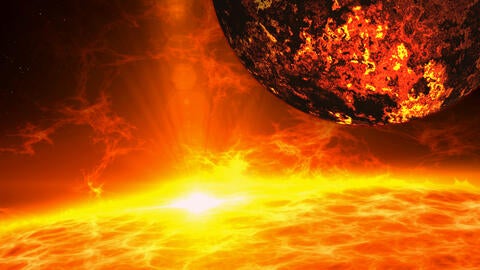- Extreme conditions on rocky planet surprise scientists
May 12, 2024
By Jules Bernstein
Riverside, CA – UC Riverside astrophysicist Stephen Kane had to double-check his calculations. He wasn’t sure the planet he was studying could be as extreme as it seemed.

Kane never expected to learn that a planet in this faraway star system is covered with so many active volcanoes that seen from a distance it would take on a fiery, glowing-red hue.
“It was one of those discovery moments that you think, ‘wow, it’s amazing this can actually exist,” Kane said. A paper detailing the discovery has been published in The Astronomical Journal.
Launched in 2018, NASA’s Transiting Exoplanet Survey Satellite, or TESS, searches for exoplanets — planets outside our solar system — that orbit the brightest stars in the sky, including those that could support life.
Kane was studying a star system called HD 104067 about 66 light years away from our sun that was already known to harbor a giant planet. TESS had just discovered signals for a new rocky planet in that system. In gathering data about that planet, he unexpectedly found yet another one, bringing the total number of known planets in the system to three.
The new TESS-discovered planet is a rocky planet like Earth, but 30% larger. However, unlike Earth, it has more in common with Io, Jupiter’s rocky innermost moon and the most volcanically active body in our solar system.
“This is a terrestrial planet that I would describe as Io on steroids,” Kane said. “It’s been forced into a situation where it’s constantly exploding with volcanoes. At optical wavelengths you would be able to see a glowing, red-hot planet with a molten lava surface.”
Kane calculated that the surface temperature of the new planet, TOI-6713.01, would be 2,600 degrees Kelvin, which is hotter than some stars.
Gravitational forces are to blame for the volcanic activity both on Io and on this planet. Io is very close to Jupiter. Kane explained that Jupiter’s other moons force Io into an elliptical or “eccentric” orbit around the planet, which itself has a very strong gravitational pull.
“If the other moons weren’t there, Io would be in a circular orbit around the planet, and it would be quiet on the surface. Instead, Jupiter’s gravity squeezes Io so much that it erupts in volcanoes constantly,” Kane said.
Similarly, there are two planets in the HD 104067 system that are farther away from the star than this new planet. Those outer planets are also forcing the inner rocky planet into an eccentric orbit around the star that squeezes it as it orbits and rotates.
Kane likens this scenario to racquetball, where the small rubber game ball bounces more and gets hotter as it is constantly hit with paddles. This effect is called tidal energy, a term used when referencing one body’s gravitational effect on another body. On Earth, tides are mostly the result of the moon’s gravity dragging our oceans along.
Moving forward, Kane and his colleagues would like to measure the mass of the flaming planet and learn its density. This would tell them how much material is available to blow out of the volcanoes.
Kane said that tidal effects on planets hasn’t historically been a big focus of exoplanet research. Perhaps that will change with this discovery.
“This teaches us a lot about the extremes of how much energy can be pumped into a terrestrial planet, and the consequences of that,” Kane said. “While we know that stars contribute to the heat of a planet, the vast majority of the energy here is tidal and that cannot be ignored.”
Source: UNIVERSITY OF CALIFORNIA, RIVERSIDE
(Cover image of molten planet: NASA, ESA, CSA, Dani Player)
Photo also courtesy of University of California, Riverside


